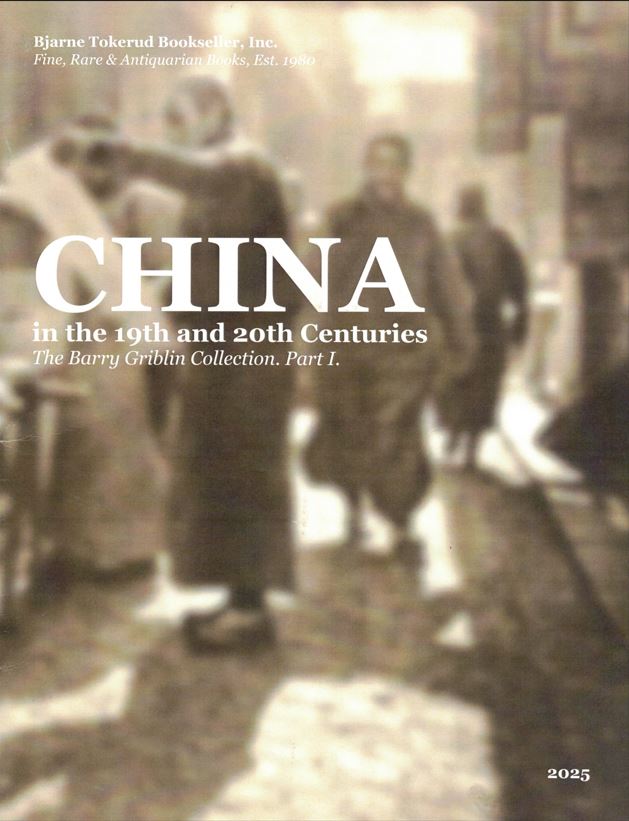China in the 19th and 20th Centuries from Bjarne Tokerud Bookseller
- by Michael Stillman

China in the 19th and 20th Centuries from Bjarne Tokerud Bookseller
Bjarne Tokerud Bookseller has published the first in a series of catalogues, China in the 19th and 20th Centuries, the Barry Griblin Collection. Part I. The late Barry Griblin grew up in western Canada, went on to study architecture and design, and moved even farther west, about as far west as you can go in Canada – Vancouver. There he practiced in the firm of Hassell/Griblin Associates. He specialized in designing homes, spectacular unique houses, something rare among all the cookie-cutter homes built today even at the upper end of the price spectrum. American refugees looking to resettle in western Canada should look for his name on a home, providing Canada will still let you in. Along the way, Barry Griblin became a book collector, and his collection is now being sold by Tokerud in a series of five catalogues.
The types of books offered fall into two categories. There are travel guides, instructional on how to get around and what to see in China. Most of the others are photobooks, books that will show you what you can see when you visit China. Additionally, there are two language guides and a book of biographies of prominent Chinese persons. The items offered are all pre-war. China was more open to western tourists in those days. After the war came the final days of the revolution, and in 1949, the country was taken over by Mao and his very austere communist party. Westerners were not welcome. Gradually, starting in the 1970s near the end of Mao's rule, China began opening up to others again, but now we are talking modern guides, not yet in the collectible category.
There are several guides available to Beijing. However, that name does not appear in any of them. Before China updated English spellings of Chinese words to more accurately reflect their sounds, it was generally known as “Peking.” These guides use the earlier spelling. They were produced locally, generally by English language publishers in China. There is a 1931 Guide to “Peking” from The Leader ($300), and a 1938 Guide to Peking from the Peking Chronicle Press ($400). Welcome to Peping (another earlier spelling) circa 1930 was prepared by the Peping-Liaoning Railway ($600). Liaoning is a coastal province, a day's train ride from Beijing/Peking.
Thomas Cook & Son, notable British travel agents, prepared Information for Travellers Visiting Peking in 1924 ($1,500). There are also two guides from Fei-Shi, Guide to Peking and Its Environs 1909 ($1,250), and Guide to Peking and Its Environs Near and Far 1924 (575).
Other guides cover Canton and China's four sacred mountains. A notable item is a very detailed, color folding map of China from the North-China Daily News & Herald, published in 1933 ($3,500). Tokerud says “this stunning map is just as much a work of impressive graphic art as it is informative.” It includes an index to streets.
The picture books may not tell you how to get there but do give you a good idea of what to see. This one offers an additional perspective. The title is La Chine a Terre et en Ballon, French for China on the ground and from a balloon. It was published in 1902 by three French army officers. Along with photos from the ground, the French officers went up in a balloon to photograph the Peking area from above. That was the only way to view it from the sky at the time as it would still be another year before the Wright Brothers made their first flight. $1,800.
There are two editions from the Scenic China series from the Commercial Press of Shanghai. Series VI is of T'ai Shan, while Series VIII is Tomb and Temple of Confucius. They are from 1916 and priced at $300 each. Views of China P.P.I.E. comes from San Francisco instead of China. The “P.P.I.E.” stands for Panama-Pacific International Exposition. That exposition was a world's fair held in San Francisco in 1915. It celebrated the opening of the Panama Canal but also San Francisco's position as a gateway to the Pacific Rim. $450.
Another major Chinese city is Nanjing, previously known as Nanking. This book is The Splendours of Historic Nanking. Eighty Photographic Studies, with Descriptive Notes, of Ancient and Modern Nanking by K.W. Kwok, published in 1933. The Preface notes of Nanking, “Its strategic position has added to the importance, as it has been the seat and abode of Emperors, as well as Generals and Warriors, in bygone days. Its historic interest is due to the fact that it was the Capital for eight generations, and during six dynasties (A.D. 420-601)... $950. Two other photobooks of Nanjing are also offered.
Finally, we have China: As She Is. A Comprehensive Album, edited by Lian Teh and published in 1934. This book provides an overview of each province, with charts on shipping, military matters, communications, etc. $650.
Bjarne Tokerud Bookseller may be reached at 604-633-0001 or bjarnetokerud@gmail.com. Their website is www.bjarnetokerud.com.